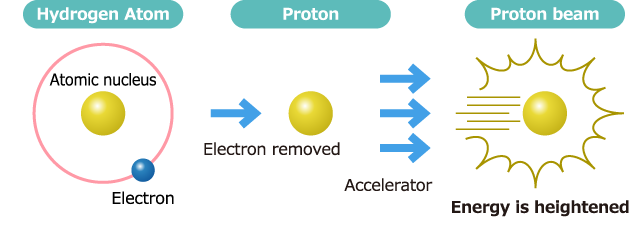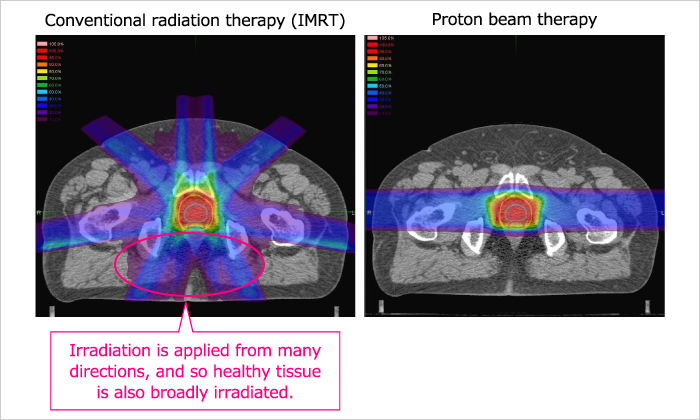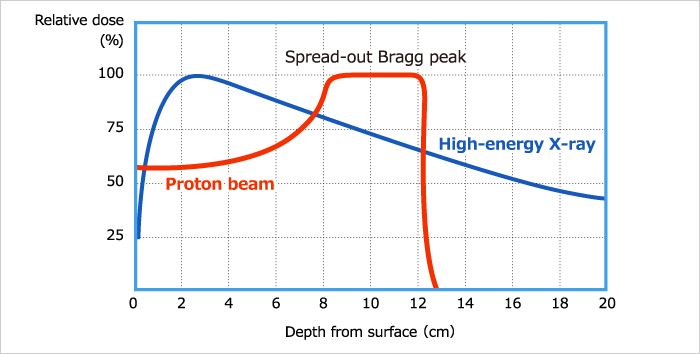What Is Proton Beam Therapy?
This is a kind of treatment using electromagnetic waves called photons that are commonly employed in radiation therapy, such as X-rays and gamma rays. Proton and other particle beams are streams of high-energy atomic nuclei, and are a kind of radiation.
Protons constitute the nuclei of hydrogen atoms, and treatment that uses beams of protons accelerated to a high-energy state is called proton beam therapy.

Features of Proton Beam Therapy
Difference in radiation distribution in the body (what is termed the "Bragg peak")
Protons, unlike X-rays, advance a certain distance into the body, then abruptly release high energy to the surrounding area and immediately disappear.
By making use of this property (the Bragg peak), characteristics such as the dose level can be adjusted so as to release concentrated high energy to cancer cells while reducing the energy released to surrounding healthy cells.
High therapeutic effectiveness can be anticipated by means of high-dose irradiation pinpointed at cancer cells, and reduced damage to healthy tissue also becomes possible, enabling treatment that keeps risk of growth and developmental disorders, secondary cancers, and other late-onset complications to a minimum.
Visualizations of radiotherapies

Dose distribution of different types of radiation

Adaptation Diseases
| Disease | Treatment period | Materials desired at first consultation |
|---|---|---|
| Head and neck cancer | 6 to 7 weeks | Head and neck CT, head and neck MRI, FDG-PET, tumor markers, pathological findings |
| Lung cancer | 2 to 8 weeks | Chest CT, brain MRI, FDG-PET, tumor markers, pulmonary function test, pathological findings |
| Postoperative thymic cancer | 6 weeks | Chest CT, pathological findings, surgical record |
| Mediastinal lymphoma | 3 to 4 weeks | Chest CT, FDG-PET, pathological findings |
| Esophageal cancer | 6 to 7 weeks | Chest CT, FDG-PET, esophageal endoscope, tumor markers, pathological findings |
| Liver cancer | 2 to 8 weeks | Chest and abdominal CT, abdominal MRI, tumor markers |
| Pancreatic cancer | 5-6 weeks | Chest and abdomen CT, abdominal MRI, FDG-PET, tumor markers, pathological findings |
| Recurrence of rectal cancer | 7 weeks | Abdominal CT, FDG-PET, tumor markers, surgical record |
| Prostate cancer | 4 to 5 weeks | Pelvic MRI, chest and abdominal CT, bone scintigraphy, tumor markers, pathological findings |
| Bone and soft tissue tumors | 6 to 7 weeks | CT, MRI, FDG-PET, pathological findings |
| Pediatric cancer | 3 to 7 weeks | CT, MRI, pathological findings (Neuroblastoma includes MIBG scintigraphy.) |
Notes
"Treatment period" values are approximate, and vary by individual case and condition.
For "materials desired at first consultation," preparations for treatment proceed smoothly when all have been obtained, but this does not mean that all are required before consultation.
Cancers That Are Untreatable Using Proton Beam Therapy
Typical cancers that cannot be treated using proton beam therapy include stomach cancer, colon cancer, uterine cancer, and skin cancer. However, it might be suitable for postoperative recurrence of colon cancer.
The irradiation field is 15 by 20 cm. Ideally, the extent of the lesion will lie within this range, but even in cases where this is exceeded, application by patchwork stitching of the irradiation fields is possible.
Obtaining suitability is difficult in cases that involve extensive lymph-node metastasis or distant metastasis to other organs. However, this differs by case, so please consult the Center.
Patients who also require hospitalization and treatment in combination with chemotherapy can commute to the Center while hospitalized at an adjacent hospital, although there are cases where we make a referral to the Hyogo Ion Beam Medical Center in Tatsuno city.






